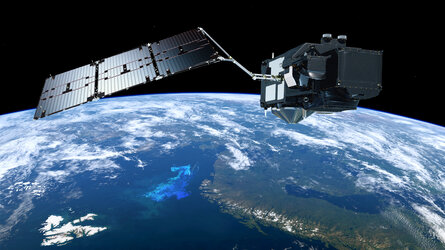World Space Alliance kicks off
While scientists and data users continue to discuss the latest findings about our changing world and the space technologies that are needed to learn more, this week’s Living Planet Symposium has also been the forum to forge and strengthen alliances. And, today sees the start of a two-year pilot for the ESA–SAP World Space Alliance.
Data from satellites are essential for understanding and monitoring our environment, and increasingly important for daily applications. While the wealth of data we have today also opens up huge opportunities for business, it needs to be made more convenient and turned into actual products that are useful for commerce.
A few years ago, ESA and SAP had already teamed up to bridge the gap between traditional Earth observation and the digitalised business world with the aim of later creating the World Space Alliance – a sort of digital market place.
To help bring satellite data to market, SAP has already incorporated data from the Copernicus Sentinel-1 and Sentinel-2 missions into a number of products on their cloud platforms – and made them available as commercial micro services. Considering the huge SAP customer base, the worldwide distribution of Copernicus data will also be further boosted. The plan is now to do the same for data from the Copernicus Sentinel-5P mission, which monitors air pollution.

In addition, SAP and ESA have held innovation workshops on the topic of aerospace data and digital platforms. This included a focus on big data – covering the task of handling, analysing and archiving huge amounts of data.
Ideas competitions have also been another highlight, ranging from annual App Camps at the Barcelona World Mobile Congress and ESA’s App Camp in Italy.
Building on these fruitful activities and further cementing their partnership, the two organisations today signed another agreement – creating the World Space Alliance. The objective is to strengthen the use of digital technologies and Earth observation data even more for a range of business sectors.
A two-year start-up phase will focus on developing SAP’s technical platforms use of innovative technologies and disruptive solutions in the field of Earth observation. During this phase, the alliance will also expand to include a limited number of partners.
The partners will be able to present their products, data and ideas on SAP platforms, ready to be accessed by other partners through individual commercial agreements. This possibility to network will promote technology and data innovation and added-value, not only for the partners, but also for individuals and, ultimately, society.
Dr Aschbacher said, “I am looking forward to this new ESA–SAP partnership, I am convinced of its success and I hope to soon welcome the first new partners.”















 Germany
Germany
 Austria
Austria
 Belgium
Belgium
 Denmark
Denmark
 Spain
Spain
 Estonia
Estonia
 Finland
Finland
 France
France
 Greece
Greece
 Hungary
Hungary
 Ireland
Ireland
 Italy
Italy
 Luxembourg
Luxembourg
 Norway
Norway
 The Netherlands
The Netherlands
 Poland
Poland
 Portugal
Portugal
 Czechia
Czechia
 Romania
Romania
 United Kingdom
United Kingdom
 Slovenia
Slovenia
 Sweden
Sweden
 Switzerland
Switzerland






























